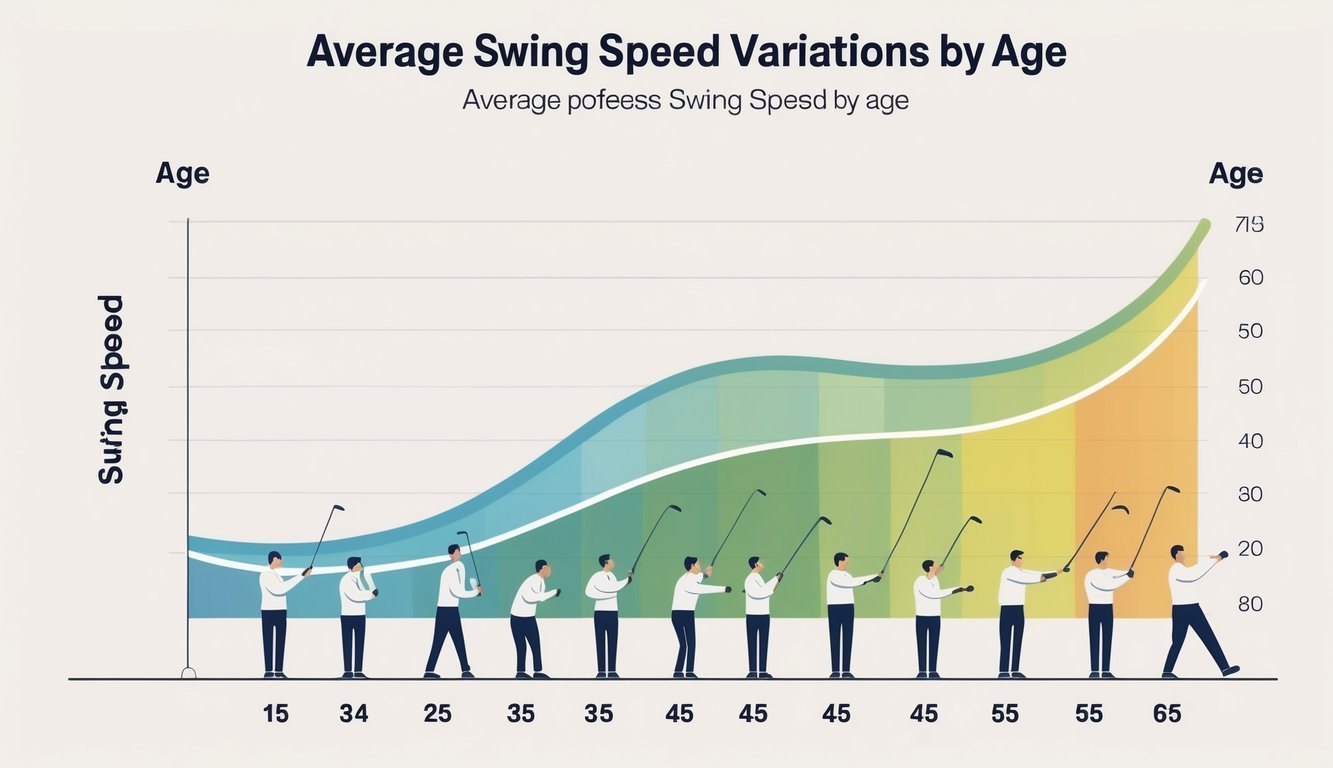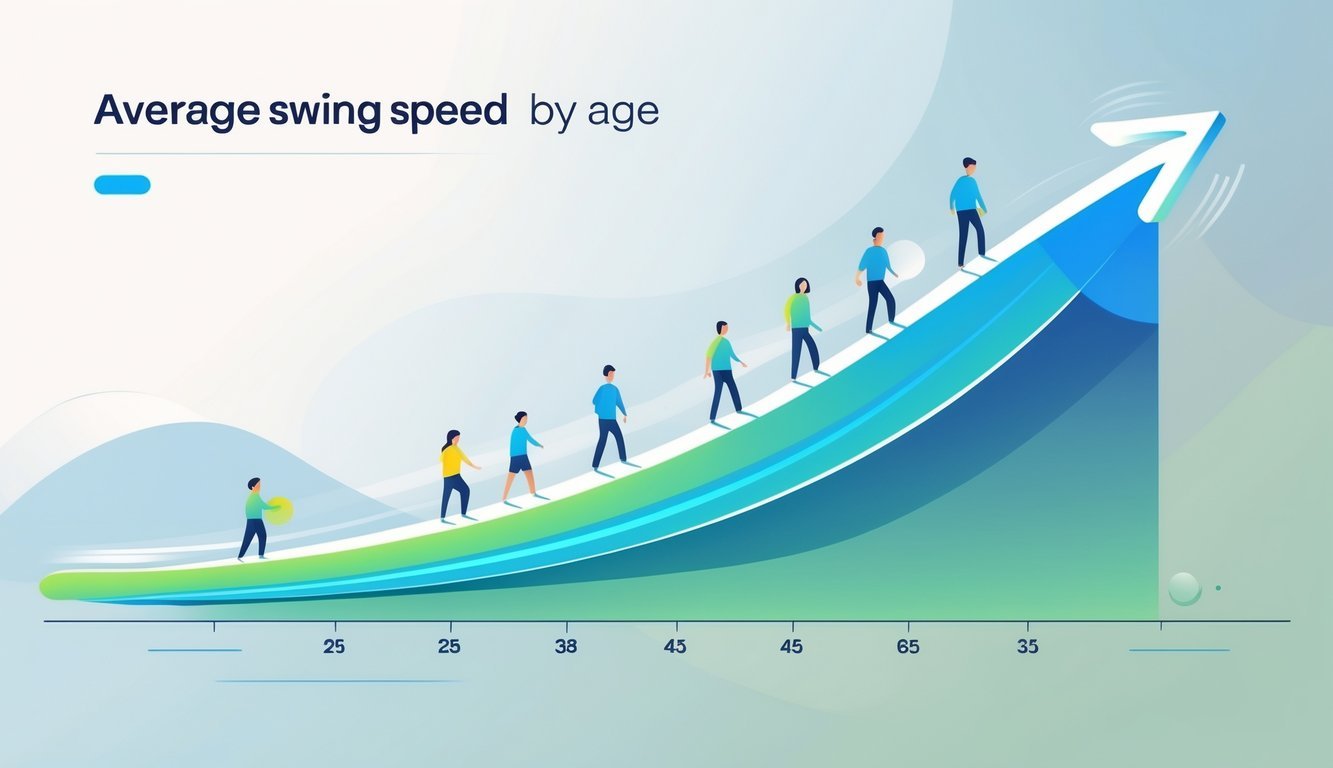PsychNewsDaily Publishers
100 Summit Drive
Burlington, MA, 01803
Telephone: (320) 349-2484
PsychNewsDaily Publishers
100 Summit Drive
Burlington, MA, 01803
Telephone: (320) 349-2484
Golf swing speed typically peaks in the 20s and 30s, then declines with age, influenced by factors such as fitness, technique, and gender differences.

Golf swing speed changes as you get older, and knowing the average speeds by age can help you figure out what to expect from your game. Younger golfers usually swing faster, peaking in their 20s and 30s, while older golfers notice a steady drop in speed as time goes on. So, your swing speed today probably doesn’t match what it was years ago.
Age is just one piece of the puzzle, though. Gender, skill level, and fitness all play a part in how fast you swing.
Checking out the average speeds by age can give you a good reference point. It helps you spot where you might want to improve.
If you’ve ever wondered what’s typical for your age group or if you can get faster as you get older, let’s dig in and see what’s possible.

Swing speed changes as you grow up and get older. Each age group shows different average speeds because strength, skill, and physical ability shift over time.
Knowing the usual speeds for your age can help you set realistic goals. You’ll also have a better shot at improving your game.
Junior golfers, usually ages 10 to 16, swing at an average clubhead speed of about 83 to 93 mph. Boys often swing a bit faster than girls at this age because of natural differences in strength and growth.
At this stage, skills and fitness can be all over the place. Juniors are still growing, so their swing speeds can jump quickly with practice and strength training.
It’s better to focus on building good technique and coordination now, rather than just swinging as hard as you can.
Teenagers, especially those between 17 and 19, see their average swing speed climb to about 93 to 113 mph depending on gender. Male teens often get close to 113 mph, which is almost at PGA Tour level, while female teens average around 93 mph, similar to LPGA Tour players.
Physical growth slows down a bit compared to juniors, but building strength and skills still matters. If you work on your swing mechanics now, you’ll likely notice better speed and distance.
Many amateurs start seeing real gains in clubhead speed during these years.
Adults aged 20 to 50 usually swing between 85 and 103 mph on average. Younger men in this group often swing faster, sometimes close to pro levels, while women are a bit slower but can still make progress with training.
In this age range, fitness and skill really count. If you stay active and keep working on your game, you’ll probably see your swing speed peak here.
Experience and technique let you hit the ball farther, and you don’t always need more power to do it.
Senior golfers, typically over 50, see average clubhead speeds drop, often below 85 mph. As you age, strength, flexibility, and mobility just aren’t what they used to be.
But here’s the good news—older golfers can still gain swing speed with the right training. Some studies show seniors, even in their late 80s, can add about 5% more speed by doing the right exercises.
Aging might slow you down, but if you work at it, you can keep or even boost your club speed and distance.

Several things shape your golf swing speed as you get older. Strength, flexibility, technique, and equipment all have a say in how fast and accurately you swing.
Training and using the right tools can help you keep or even improve your club speed at any age.
Muscle strength in your core, arms, and legs drives how fast you can swing. As you age, you lose some muscle and grip strength, which can bring down your club speed and distance.
Flexibility matters, too. Stiff joints and tight muscles limit your motion, making your swing feel stuck. Stretching and mobility work help keep your swing smooth and strong.
Staying fit with regular strength training and stretching slows down the loss of swing speed. If you focus on core and grip strength, you’ll have more control and power in your drives.
Good swing technique lets you use your strength and speed better. Proper mechanics generate power without extra effort and help prevent injuries.
Timing, balance, and clubface control all shape your swing’s consistency. Even minor flaws in your form can cut down your smash factor and distance.
Experience and skill help you make solid contact, control spin, and launch the ball well. Lessons and video analysis (maybe with a launch monitor) can help you fine-tune your swing for more efficiency and longer drives.
Golf equipment that fits your swing and body can really make a difference. Club fitting tweaks club length, weight, and flex to match your strength and speed.
Modern training aids and tech give you feedback to sharpen your swing and power. Weighted clubs or speed trainers can safely build muscle and boost club speed.
Regular practice and proper warm-ups get your muscles ready and improve your range of motion. As you see progress, your confidence grows, which makes swinging faster feel more natural.

Swing speed changes as you age, and it varies by gender and skill level. Lots of golfers wonder when these shifts happen and how to get faster.
Women golfers usually swing slower than men, and their speeds drop gradually over time. In their 30s and 40s, most women average about 70-80 mph with a driver, and by their 60s, it’s often down to 60-70 mph.
Swing speeds with irons start to drop noticeably around age 55. This decline keeps going as you move into your 60s and beyond, mostly because of less strength and flexibility.
Around 70, many golfers see a sharper drop in swing speed, sometimes losing 10-15 mph from their best years. That can cut down your driving distance, but it doesn’t mean you can’t still enjoy the game.
Yes, men almost always swing faster than women at every age. The gap stays pretty steady, with men swinging about 20-30 mph faster on average.
You can boost your swing speed through strength training, flexibility work, and improving your swing technique with a coach. Trying lighter clubs and focusing on accuracy can help you hit longer shots without using extra effort.
You’ll usually find that lower handicap golfers swing the club faster. That’s not the whole story, though.
Good technique and accuracy play big roles in scoring well, too. It’s not just about speed.